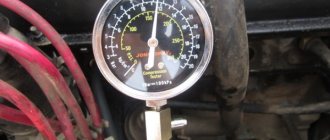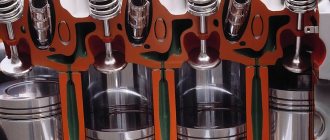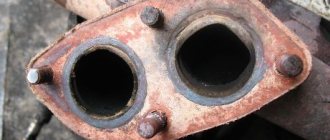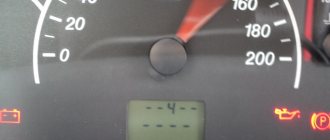05 February 2016 Lada.Online 76 153 10
How to quickly and accurately determine the condition of the engine? Check the compression in the cylinders! Is the engine running rough, you feel a loss of power, the consumption of engine oil or fuel has increased and the car has become difficult to start in cold weather? All of these problems may be caused by low compression in one or more cylinders.
Checking compression in VAZ 2170 cylinders
Compression (pressure at the end of the compression stroke) in the cylinders is the most important indicator for diagnosing the condition of the engine without disassembling it.
Based on its average value and the difference in values in individual cylinders, it is possible to determine with a sufficient degree of accuracy the degree of general wear of parts of the connecting rod and piston group of the engine, and identify malfunctions of this group and parts of the valve mechanism. Compression is checked with a special device - a compression meter, which can now be freely purchased at large auto parts stores.
| Note This is what the compression gauge used to illustrate this book looks like. There are variants of compression gauges in which, instead of a threaded fitting for screwing in, a rubber tip is installed instead of a spark plug. When checking compression, such compression gauges are simply pressed firmly against the spark plug hole. |
| Warning Important conditions for correct readings when checking compression are the serviceability of the starter and its electrical circuits, as well as the full charge of the battery. |
1. Start the engine and warm it up to operating temperature.
2. Reduce the pressure in the power system (see “Reducing fuel pressure in the engine power system”). After reducing the pressure, do not replace the fuel pump fuse to turn off the fuel pump.
3. Remove the ignition coils and remove all spark plugs (see “Replacing and servicing spark plugs”).
4. Screw the compression gauge into the spark plug hole of the cylinder being tested.
5. Press the accelerator pedal all the way to fully open the throttle.
6. Turn on the starter and turn the engine crankshaft until the pressure in the cylinder stops increasing. This corresponds to approximately four compression strokes.
| Note To obtain correct compression gauge readings, the crankshaft must rotate at a speed of 180–200 min-1 |
7. After recording the compression gauge readings, set its needle to zero by pressing the air release valve.
| Note For compression meters of a different design, readings can be reset in other ways (in accordance with the instructions for the device). |
8. Repeat steps 4–7 for the remaining cylinders. The pressure must not be lower than 1.0 MPa and should not differ in different cylinders by more than 0.1 MPa. Reduced compression in individual cylinders can result from loose valve seats, damaged cylinder head gaskets, broken or burned piston rings. Reduced compression in all cylinders indicates wear of the piston rings.
9. To find out the reasons for insufficient compression, pour about 20 cm3 of clean engine oil into the cylinder with reduced compression and measure the compression again. If the compression gauge readings increase, the piston rings are most likely faulty. If the compression value remains unchanged, it means that the valve plates do not fit tightly to the seats or the cylinder head gasket is damaged.
| Helpful advice The cause of insufficient compression can also be determined by supplying compressed air to the cylinder, in which the piston is pre-installed at TDC of the compression stroke. To do this, remove the tip from the compression gauge and attach the compressor hose to it. Insert the tip into the spark plug hole and supply air to the cylinder at a pressure of 0.2–0.3 MPa. To prevent the engine crankshaft from turning, engage the highest gear and brake the vehicle with the parking brake. The release (leakage) of air through the throttle assembly indicates a leak in the intake valve, and through the muffler indicates a leak in the exhaust valve. If the cylinder head gasket is damaged, air will escape through the neck of the expansion tank in the form of bubbles or into the adjacent cylinder, which is detected by a characteristic hissing sound. |
Video about “Checking compression in cylinders” for VAZ 2170
Compression measurement 16 valve engine
Compression measurement on 16-valve Kalina and Priora
Priora compression measurement
To ensure that the compression test gives accurate results
Compression depends not only on the technical condition of the engine, but also on the conditions under which it is measured. Make sure that during the check:
- the compression gauge was working properly;
- the engine has been warmed up to operating temperature (up to 90 degrees);
- the throttle valve was fully open;
- spark plugs in all cylinders must be turned out;
- the starter was fully operational;
- the battery was fully charged;
- The engine air filter was clean.
What is compression
When the piston moves upward, it compresses the air-fuel mixture that fills the chamber. In order for fuel combustion to be as efficient as possible, it is necessary to ensure sufficient pressure in the cylinders (this is compression). After all, the higher the pressure at the beginning of the power stroke, the stronger the exhaust gases press on the piston, forcing it to turn the crankshaft. If the engine compression is insufficient, the following happens:
- fuel burns inefficiently, causing engine power to decrease;
- exhaust gases break into the engine crankcase, which leads to oil oxidation;
- Burning gases breaking through the gasket, piston rings or valves damage their surface and further reduce the pressure.
The rotating connecting rod pushes the piston upward. Closed valves, head gaskets and piston rings prevent gases from escaping from the combustion chamber, causing pressure to build up. When the piston has almost reached top dead center (TDC), the air-fuel mixture ignites. As a result of this, the pressure in the combustion chamber increases sharply and begins to look for a way out - through the piston, connecting rod and crankshaft. Thus, the pressure in the combustion chamber is converted into rotation of the crankshaft. Compression determines how much combustion products will push the piston, and how much will go into the cooling or lubrication systems to spoil the engine.
Causes of increased compression in engine cylinders
For most experienced car enthusiasts, it is well known that the ease of starting the internal combustion engine, as well as the stability of the further operation of the power unit, directly depends on the compression ratio in a gasoline or diesel internal combustion engine. Compression also greatly affects power, fuel and engine oil consumption, as well as the life of the power plant.
As a rule, many drivers and auto mechanics, during superficial diagnostics, identify a number of breakdowns and determine the general condition of the engine precisely by the compression indicator. At the same time, measuring compression in the engine is not difficult. This operation is easy to implement in a regular garage; the engine does not need to be disassembled, and no special tools or equipment are required.
It is enough to unscrew the spark plugs on a gasoline engine or the glow plugs on a diesel engine, after which a compression gauge is installed through an adapter into the spark plug wells. Then the engine is cranked from the starter, measuring the compression readings in each cylinder and comparing them with the norm for a particular type of internal combustion engine.
However, although measurements are relatively easy to take, accurately determining the cause of deviations from the norm is much more difficult, since compression can be low or high for a variety of reasons. Next we will talk about why increased compression occurs in the engine, and why it can also decrease.
High compression in the engine
So, as mentioned above, compression in the power unit can be influenced by a number of factors. Let's start with increased compression. First of all, increased compression usually indicates that there is a problem with the engine. As a rule, the main symptom is unstable engine operation, discoloration of the exhaust and increased oil consumption.
Typically, in many cases, car enthusiasts are faced with so-called “oil” compression, when general engine coking and problems with oil scraper rings lead to excess oil and carbon deposits actually reducing the volume of the combustion chamber. The result is an increase in compression.
In other words, an increase in compression is caused by carbon deposits on the timing valves, the accumulation of coke in the combustion chamber and the occurrence of oil scraper rings. A common cause is also engine overheating, when oil loses its properties due to high temperatures and quickly contaminates the combustion chamber.
Other reasons include the use of additives in the lubrication system, pouring inappropriate or low-quality oil for the engine, constant operation of the engine on low-grade fuel, etc.
One way or another, the accumulation of coke and soot leads to a decrease in the volume of the combustion chamber in which the fuel-air mixture is compressed. Naturally, in this case, when taking measurements, the compression meter will show too high a compression.
Let us also add that deviations from the norm can be caused by incorrect installation of valve timing. Simply put, errors when aligning the pulleys when replacing a timing belt or chain will lead to the drive element jumping several teeth (on an internal combustion engine with a belt) or links (on chain engines) forward or backward.
Reasons for decreased engine compression
There are many factors that influence the reduction of engine compression. Let's look at the main ones.
The amount of air in the cylinders.
A high compression ratio is directly proportional to the amount of air entering the engine cylinder; a decrease in air volume, accordingly, leads to a decrease in pressure in the cylinders when they reach TDC (top dead center).
Reasons for reducing the volume of air in the cylinders:
Setting the valve timing.
Errors in setting the valve timing can lead to changes in the closing and opening times of the exhaust valves, which leads to a shift in one direction or another when the maximum pressure in the cylinder is reached, and accordingly the compression will be different.
Such errors, as a rule, are the result of incorrect installation of the camshaft drive belt, so entrust this work to specialists.
Reasons why there is no compression in the cylinder
Poor (small) compression in one or all cylinders indicates engine wear. There is an old and simple way to determine why compression has disappeared. You need to pour a tablespoon of engine oil into the spark plug hole and repeat the measurements:
- if the pressure has increased noticeably, it means the piston rings have poor sealing;
- if the pressure has not changed, then there may be several reasons (for example, leaking valves, broken gaskets under the cylinder head, there is a crack or burnout in the walls of the combustion chamber, in the piston bottom).
There is another, more accurate way to find out why compression has disappeared. To do this, you will need to modify the spark plug. We remove the insulator from it, and weld the valve of the car camera to the metal body. Next, set the cylinder piston to the ignition timing position, remove the radiator caps and oil filler neck, screw in the manufactured adapter and pump air into the cylinder using a pump (create pressure in it):
- if air enters the exhaust pipe, it means the exhaust valve is poorly sealed;
- If air goes into the intake manifold, there is a problem with the intake valve.
- if bubbles appear in the expansion tank, then check the cylinder head gasket;
- If there is a hissing sound in the oil filler neck, it means that the piston rings are not properly sealed.
Engine diagnostics using compression measurements in the cylinders allows you to quickly and accurately determine its condition without disassembling, and in some cases will help avoid major repairs of the power unit. Have you ever experienced a lack of pressure in the cylinders? What was the cause of the malfunction? If engine problems persist, check the fuel rail pressure.
Compression measurement
We carry out a compression test for a general assessment of the technical condition of the parts of the cylinder-piston group and the engine valve mechanism. We carry out the test with the engine warmed up to operating temperature. We relieve the pressure in the engine power supply system (see “Replacing the fuel filter”) and do not replace the fuel pump fuse. We unscrew the spark plugs from the cylinder head (see “Checking the condition and replacing the spark plugs”). Disconnect the engine management system wiring harness block from the ignition coil wiring harness block (see “Removing and installing the engine”).
Install the tip of the compression gauge into the spark plug hole of the cylinder head. We connect the wire terminal to the “negative” terminal of the battery. We turn the crankshaft with the starter with the gas pedal fully pressed for 2–4 s (the pressure gauge readings should stop increasing). We record the pressure gauge reading and relieve the pressure in the compression gauge. To correctly assess compression, the battery must be fully charged - the crankshaft revolutions when cranking must be at least 180 min -1. Similarly, we check the compression in other engine cylinders. The compression of a working engine should be in the range of 11.0–13.0 bar, and the difference in readings between the cylinders should not exceed 2.0 bar. To find out the reasons for low compression, pour 10–15 cm 3 of engine oil into the cylinder through the spark plug hole and repeat the measurement. If, upon repeated measurement, the compression increases by more than 2.0 bar, the most likely cause of the malfunction is severe wear, sticking or breakage of the piston rings. If the pressure gauge readings do not increase after filling the oil, then most likely the valve plates do not fit tightly to the cylinder head seats. This can happen if the valve drive malfunctions, as well as with excessive wear, burnout or damage to the valve discs or seats. The cause of the malfunction can only be definitively determined after disassembling the engine.
good day, today they measured the compression on my Priora, according to the measurement results it was 17 in two cylinders, 16 in the other two, how could this be and what could be the problem? Anyone who has encountered this, please let me know.
Alternative
A more complex, convenient, but not much more effective device. The main difference is the ability to record the received data on plastic cards or paper at different periods of time and subsequently analyze them.
But if you want to track the increase in pressure over time, it will be difficult with this device. This is the main disadvantage of the compressograph.
They are the most modern instruments for measuring engine compression.
Their operating principle is not based on fixing the pressure in the cylinders, but on measuring the pulsation of the current consumed by the starter.
The strength of the current consumed is directly proportional to the increase in compression in the cylinders and the increasing load on the engine crankshaft.
The main advantage of this device is that in just a few minutes you can take readings from all cylinders without unscrewing the spark plugs.
How to determine why the compression in the cylinder has dropped?
If it is determined that in one of the cylinders the compression is below normal, it is necessary to determine what exactly caused the problem.
To more accurately determine why the pressure in the cylinder dropped, you should carry out several simple procedures:
- Pour 10-15 g into the cylinder with reduced compression. engine oil, then measure again. If the indicators have improved, it means that the reason for the fall lies in the rings (they are stuck or one of them has burst);
- Remove the valve cover and check the valve clearances on the required cylinder;
- Carefully inspect the engine at the junction of the head and the block. If there is a gasket breakdown leading outward, oil leaks will be visible;
- Pull out the dipstick and assess the condition of the oil. If it is very blackened and a burning smell is clearly visible, then this may indicate a breakdown of the gasket, in which the cylinder is connected to the oil channel;
- Assemble the engine and start it. Then you should inspect the expansion tank of the cooling system. If escaping air bubbles are visible in it, this will signal the connection of the cylinder with the channel of the cooling system. Additionally, you can put your hand on the exhaust pipe while the engine is running. If small sweet-tasting drops remain on the palm, this will indicate that coolant has entered the cylinder, that is, there is a breakdown.
If all the procedures carried out did not produce results, that is, after filling the oil, the compression did not increase, the thermal clearances are normal and there are no prerequisites for a breakdown of the cylinder head gasket, then the reason lies in the piston, valves or cylinder head.
But to make sure of this, you will have to remove the block head.
All reasons for low compression
If you experience loss of compression or sag in one of the cylinders, you should look for the exact cause as follows.
From above, valves are responsible for the tightness of the combustion chamber, but a decrease in compression can be not only due to leaks in the valve disc/valve seat pair. Tar deposits on valves can reduce the intake port area (additional intake resistance), or even prevent the valve from closing completely. The appearance of deposits on the valve and disruption of its contact with the seat lead to deterioration of heat dissipation (heat from the valve is dissipated through the seat to which it is adjacent) and, subsequently, to burnout of the valve. But the valve can also burn out due to a decrease in the thermal gap: in this case, when the engine warms up, the valve will no longer fit normally to the seat. The resulting annular gap between the valve disc and its seat reduces compression. Hot gases burst through this gap and burn the thin edge of the plate, which further reduces compression. The engine loses power and the valve disc burns out.
Incorrectly set valve timing can cause a decrease in compression due to untimely opening/closing of the valves. This problem affects all cylinders equally, i.e. no compression differences between the cylinders will be detected.
Some modern engines regulate the supply of air to the cylinders not with the throttle valve that is familiar to us, but with the height/phases of lift of the intake valves (Valvetronic for BMW, MultiAir for Fiat, etc.). Theoretically, if there is a malfunction in the valve lift adjustment system, compression can also decrease, because The lift of the valves during measurement may not be complete. The effect of this fault on all cylinders will be the same if the fault is permanent. However, if the malfunction is of a floating nature, the compression measurement will show new data each time, and in this case it is reckless to judge the malfunction of a particular cylinder by compression. The cause may be either a malfunction of the exhaust valve timing control solenoid valve or a sensor failure.
From below, the elements of the cylinder-piston group are responsible for the tightness of the combustion chamber. A decrease in compression is caused by wear and, as a consequence, an increase in gaps in the CPG, which is also accompanied by an increased passage of gases into the crankcase. The same consequences are caused by a change in geometry (deformation of the piston or cylinder) due to engine overheating, stuck rings, scuffs on the cylinder bore, or a broken compression ring. A burnt-out piston first of all manifests itself as extraneous noise when the engine is running, and only then by a decrease in compression in the cylinder.
Separately, we highlight the burnout of the cylinder head gasket. This malfunction can be further checked by creating pressure in the cylinder with the valves closed (for example, with a compressor), and observing the appearance of bubbles in the expansion tank of the cooling system, or by hearing noise in an adjacent cylinder.
For a preliminary general assessment of the compression ratio in the cylinders of a gasoline engine, the following conditions must be met:
- warmed up to operating temperature;
- spark plugs are removed from all cylinders;
- the fuel supply is turned off (on injection engines it is enough to turn off the crankshaft position sensor, on carburetor engines - turn off the fuel supply from the fuel pump);
- the battery is fully charged or additionally connected to the starter;
- the starter is working;
- the clutch pedal is fully depressed;
- the throttle valve is fully open;
- The measuring modes for all cylinders are the same in terms of the starter cranking time (or the number of strokes).
Reasons for a drop in compression in one cylinder
It also happens that a pressure drop occurs in one of the cylinders, and significantly (in some cases, compression can drop to 3-4 kgf/cm2).
And such diagnostic results are a reason to worry, because there are malfunctions in the power plant.
The reasons for a drop in compression in one of the cylinders above normal may be:
- COMPRESSION RINGS. These elements play one of the most important roles, since their task is to ensure tightness in the piston-cylinder pair. If the rings are damaged (burst) or stuck, they will begin to leak working gases into the sub-piston space, which is why a significant drop in compression occurs;
- VALVES. Through these elements, the components of the combustible mixture are admitted and exhaust gases are removed. But during the compression stroke, the valves are closed, which seals the combustion chamber. But if, due to a violation of the combustion processes, the edge of the valve plate and seat are burnt, or the thermal gap is broken, and it turns out to be slightly pressed, then the tightness of the chamber is not maintained, which affects the compression;
- PISTON. This element is rarely to blame for a drop in pressure in the cylinder, but there are still situations when the reason lies precisely in it. As a result of the same process changes, the piston crown may burn out. This usually happens due to a violation of the ignition angle. And if the piston burns out, then there will be no tightness;
- BLOCK HEAD. Although rare, it does happen that cracks and other defects appear in the combustion chamber, affecting the loss of compression. Also, the head can cause a loss of pressure in some cylinder if it fails due to overheating. Due to changes in geometry, the head in some places simply does not fit tightly to the gasket. Even a simple insufficient tightening of the cylinder head bolts can affect compression;
- cylinder head gasket. Due to internal defects or overheating, a breakdown of this gasket may occur. As a result, one of the cylinders is connected to a channel of the cooling or lubrication system, another cylinder (in this case, a strong drop in compression is observed in two cylinders), and the breakdown can also lead out of the engine. Read more about the signs of a broken cylinder head lining.
Also read why the car engine does not pull.
Signs of a problem or lack thereof
If there is no compression in one cylinder or in several, this can be determined by the following symptoms:
- Reduced pressure will be indicated by difficulty starting the engine. When trying to start, the driver will turn the flywheel with the starter much longer than usual. If the pressure disappears completely, starting will become almost impossible.
- An engine with low compression in one of the cylinders will triple and operate with less stability. Since there is no compression in one cylinder, the speed at idle will be unstable. This will also be reflected in the acceleration dynamics.
- Such an engine will certainly have increased fuel consumption. Determining this symptom is quite difficult for those who do not monitor this indicator. But for those who know the consumption for a certain mileage, the increase in engine appetite will be immediately noticeable.
- There will definitely be problems with the combustion chambers. When driving uphill, the hydraulic compensators may begin to knock. This will be especially noticeable and audible when driving at low speeds.
- In diesel power units, you can determine that there is no compression in one cylinder by characteristic popping sounds.
- Sometimes the pressure in the lines where the coolant circulates may increase. Due to low compression, antifreeze will be squeezed out from under the gaskets, from under the pipes and other seals.
- If compression is poor (if it is due to a broken cylinder head gasket), the tightness of the system is compromised. If you open the hood, you will see exhaust gases passing through the gap in the gasket. This malfunction leads to rings sticking on the pistons, which will contribute to increased oil and fuel consumption. In some cars, this symptom may be accompanied by an increase in power and the formation of white smoke from the exhaust pipe.
A popular way to eliminate stuck rings and increase compression
This method does not guarantee that the compression meter readings will change. But, it is actually effective if different compression in the cylinders was formed precisely because of the position of the rings. At a minimum, your conscience will be clear, and you will then exclude this item from the diagnosis.
We purchase high-quality valve cleaning fluid. The instructions for it should indicate that it is added to engine oil. This evening we unscrew all the candles and pour 50-70 ml into the cylinders. this liquid using a bulb or syringe. In the morning, after 12 hours, crank the engine, then clean the spark plugs and adjust the gaps, and only then screw them into place. When starting the engine, do not be alarmed by the quality and quantity of smoke from the exhaust system. You enter the road to pass sections at higher speeds. That is, the task is to give the engine maximum load. Therefore, think in advance where you will do this. Consider the condition of the road surface, weather conditions, traffic intensity
Ideally, this is done on a country road. Important! The previous point must be fulfilled, otherwise the coking products that have come loose overnight will fall under the valve and then disassembling the cylinder head will not be avoided. After running at a speed of 100-120 km/h over a section of 10-20 km. measure the compression in the cylinders again.
There are two options here: joy and a feeling of happiness from seeing numbers of the same compression, which corresponds to the norm. Or bitterness from the upcoming operation with disassembling the cylinder head and diagnosing the engine. There is no third.
Good luck with eliminating compression differences between the cylinders.
Expert opinion
Ruslan Konstantinov
Automotive expert. Graduated from Izhevsk State Technical University named after M.T. Kalashnikov, specializing in “Operation of transport and technological machines and complexes.” More than 10 years of professional car repair experience.
If in one of the “pots” the pressure is significantly lower than in the others (for example, everywhere is 11.5, and in the only one 6.0 atmospheres), this indicates a difference in compression. Naturally, this negatively affects the operation of the power unit. Often a drop in compression can be observed in several “pots”. However, in this case, we can safely say that the engine needs urgent overhaul. There can be many reasons for a drop in compression; elimination requires dismantling the cylinder head. Here are the main reasons: 1. Broken (burnt out) cylinder head gasket. One of the most common causes is “treated” by replacing this element.2. The cylinder head is not tightened enough. Actually, the above reason follows from this: the gasket begins to leak pressure and eventually breaks through.3. They miss the rings. This phenomenon occurs if the o-rings are severely worn or broken. If the pressure drops in one “pot”, the rings are guaranteed to be broken. In this case, a major overhaul of the engine is required.4. Coking. The rings become coated with coke due to the use of low-quality motor oil or due to high mileage. The oil burns out and the rings stick in one place, unable to move along their grooves. Only one side is ground down, which means the engine wears out faster. Coking is indicated by a drop in compression in all cylinders.5. Wear of the cylinder block walls. This is a rare phenomenon and most often occurs due to the manufacturer using low-quality materials.6. Engine overheating. If the engine overheats, the rings and the walls of the block begin to leak pressure, and with it the oil. Partially can be identified by bluish smoke from the exhaust pipe.7. Piston burnout. If the piston is broken, the compression in the cylinders will be virtually zero. It can burn out from both the top and the side. Often, pistons break when the timing belt breaks when, due to a violation of the valve timing, they encounter the valves.8. valves. Compression may drop due to improper adjustment, burnout or breakage when the timing belt breaks.
Home →
Practical advice →
Malfunctions →
Motor 126 and 127: working life, differences
These engines on Priora had a displacement of 1.6 liters (or 1596 cm3). Optimal for city sedans, the engine size of the Lada Priora gave a good combination of dynamics and consumption: along with very decent acceleration, fuel consumption does not exceed sky-high numbers. Both engines received good marks, because the car behaved perfectly in the city and on the highway.
In fact, the 126 Priora engine became the first sixteen-valve engine for this model, and the 127 is a modified version, “overclocked” by AvtoVAZ designers. In addition to the same engine displacement, they have other identical characteristics. The in-line type of arrangement of four cylinders provides a simplified design that can be repaired on your own.
The distributed multipoint injection system is involved in creating a good, rich fuel-air mixture (a lean mixture can lead to breakdowns). The cylinder diameter is 82 mm, the piston stroke is 75.6 mm, the compression ratio is 11. The “engines” fall under the Euro 4 standard, they are powered by gasoline with an octane rating of 95.
The 126 engine for the Priora received the following characteristics: 98 hp. (72 kW at 5600 rpm), acceleration to 100 km/h in 11.5 seconds (with manual transmission), city consumption 9.1 l - 100 km (manual transmission), maximum torque - 145 Nm.
The 127 engine for the Priora was upgraded to the following figures: 106 hp. (78 kW at 5800 rpm), acceleration to 100 km/h in 11.5 seconds (with manual transmission), city consumption 8.9 liters per 100 km (with manual transmission), maximum torque – 148 Nm.
The difference may not seem so noticeable, but this is a very small but strong step in design on the part of AvtoVAZ (this is where the change to sixteen-valve “engines” with a volume of 1.6 liters ended). For a car of the Lada Priora class, the engine power was sufficient.
In the same block it is necessary to say about the operating temperature. An absolutely normal operating temperature is considered to be between 90 and 95 degrees Celsius. Further, when the car is being pushed in a traffic jam, is basking in the sun, or for some other reason, but can still work - from 97 to 110 degrees. The engine is slow in places and wears out a lot, but you can still get to your destination. A temperature below 90 degrees is a direct sign indicating that the car has not yet warmed up, and it is better to wait in place until the arrow points to the coveted 80-90 mark.
Operating a car at temperatures above 110 degrees is dangerous because the service life of the engine is noticeably reduced - hot parts undergo very severe wear, overcoming the force of friction.
In general, the service life of the Lada Priora engine with a normal driving style and careful treatment is 200,000 km - after this mark the time comes when the “engine” requires major repairs. AvtoVAZ mentioned the timing belt separately as a recommendation, saying that it needs to be checked every 100,000 km (many car enthusiasts talk about the figure of 50,000 km).
Read more: How to check the gas temperature sensor
All Lada engines have a problem, and it is related to the valves, which will be discussed further.
Factory compression on Lada Priora
It is believed that if the compression is less than 13 on a Priorov engine, then this will lead to immediate problems. The engine on the Priora is very high-torque, if the compression is less than 12, then the thrust will no longer be the same. That is, the minimum compression is about 12 atmospheres.
Compression check
Even for cars with a significant mileage, this parameter should not decrease less than 12 atmospheres. In your case there is a problem with the first cylinder, there could be many reasons. If I were you, I would get into the engine with capital only after a serious oil leak appears or the traction disappears completely.
Let's get started!
To check compression on a Priora, the following tools are required:
- spark plug head;
- compression gauge;
- extension;
- knob;
- 10 mm head.
To measure compression on a 16-valve engine:
- Warm up the engine until it reaches operating temperatures.
Working temperature.
- To remove the plastic casing, you need to pull it towards you.
- Unscrew 4 spark plugs. To do this we use a key of 16.
You can inspect the condition of the spark plug wells with a flashlight.
- Disconnect power from the coils. To do this, disconnect the wiring harness block.
- Make sure the compression gauge is reset to zero. Next, install the measuring device in the hole of the first cylinder.
- Now you need to get behind the wheel and press the gas pedal all the way. Then we start the engine and turn the starter until the pressure stops increasing.
Capital is close. But you can drive!
- Turn off the ignition. We evaluate the compression level.
Simple gasket test
If there is insufficient compression, you need to pour a little oil into the cylinder. Then we check again. When increasing the parameters, the problem should be looked for in the piston rings. If nothing changes as a result of the addition, then the head gasket will have to be replaced.
The following two tabs change content below.
- About the author:
- Latest articles:
I'm just sick of cars. I try to study in detail every car I have owned. I enjoy driving at night on city streets. I try to do my own repairs on my cars!
Similar materials
Tags: Questions Lada PrioraLada Priora
see also
Comments 29
I bought a viburnum with a 126 engine not so long ago, compression 9.6,14,12,14, mileage 127 thousand, I pour 150-200 grams of oil every week, and the question is, is the problem in the valves or does the engine need to be completely rebuilt?
If the compression differs by more than 1, it means there is a problem with the piston. Maybe the rings are stuck, maybe something else
good compression, don’t listen to anyone) I have one myself and the mileage is 100 thousand) when the rings are stuck, it will be visible to the naked eye from the exhaust fog will go around)
13 is very good for a 126 engine, the compression ratio from the factory is 11! Increased compression with in your case, you need to figure out the cause, fortunately there are few of them! Find a normal motor mechanic.
In 126 engines this is normal. On my Priora the same thing happened even after 92 thousand. mileage I was interested in the mechanics, they said this compression is due to the lightweight piston. And oil consumption in these engines seems to be the norm, although some write, from replacement to replacement. An acquaintance took a new one from the dealership, after the first replacement it began to eat up, and someone drills additional holes in the piston, in the oil scraper groove when replacing the caps. They say it helps.
There shouldn’t be any oil-guzzling at all! There is no need to drill short pistons, because... They are already designed correctly!
Compression is quite good, the only question is that the oil scraper rings could have worn out, due to a good film of oil, that’s why the compression is so good...
13.8 in each cylinder was
Meryl the other day. 16 and further the pressure gauge needle goes off the scale











